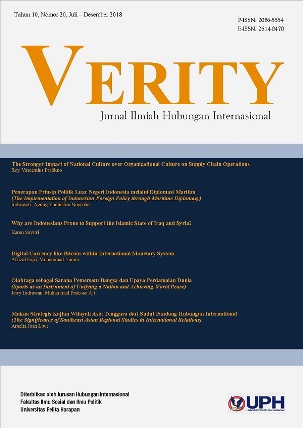Digital Currency like Bitcoin within the International Monetary System Field
DOI:
https://doi.org/10.19166/verity.v10i20.1458Λέξεις-κλειδιά:
digital currency, cyberpolitics, international monetary system, BitcoinΠερίληψη
Monetary transactions are no longer limited to traditional patterns as electronic systems using internet technology can facilitate whenever and wherever transactions without any face-to-face interaction. In terms of payment methods, this technology is developing and known as digital currency. Bitcoin is the digital currency with the largest market value. It is an electronic payment system based on a mathematical systems. The idea is to produce an independent currency that is not tied to a particular central authority and has very low transaction costs. Digital currency uses the concept of cryptography to provide basic security functions, such as ensuring that Bitcoin can only be spent by those who have it and it cannot be duplicated. The emergence of this currency has caused controversy in many countries because of its unregulated nature. This study examines Bitcoin and whether it is categorized as money based on the concept of money and how the three main international monetary institutions (IMF, WTO, World Bank) respond to its presence with a basic analysis using the concept of cyberpolitics. This study concludes that Bitcoin has not fully met the criteria as a currency and there are no specific rules yet regarding the existence of digital currency.
BAHASA INDONESIA ABSTRAK: Berbicara Transaksi, saat ini tidak lagi hanya terbatas pada pola tradisional, melainkan sudah berkembang menjadi lebih jauh ketika Transaksi difasilitasi oleh system elektronik dengan menggunakan teknologi intrenet, sehingga kapanpun dan dimana pun transaksi dapat dilakukan tanpa bertatap muka langsung. Dalam hal metode pembayaran, teknologi ini juga berkembang. Baru-baru ini dikenal juga istilah mata uang digital. Salah satunya adalah Bitcoin. Ini adalah mata uang digital dengan nilai pasar terbesar. Ini adalah sistem pembayaran elektronik yang didasarkan pada sistem matematika. Idenya adalah untuk menghasilkan mata uang independen yang tidak terikat pada otoritas pusat tertentu, dengan biaya transaksi yang sangat rendah. Mata uang digital menggunakan konsep kriptografi untuk menyediakan fungsi keamanan dasar, seperti memastikan bahwa Bitcoin hanya dapat digunakan oleh mereka yang memilikinya dan tidak dapat diduplikasi. Munculnya mata uang ini menimbulkan kontroversi di banyak negara karena sifatnya yang tidak diatur. Studi ini meneliti Bitcoin apakah dikategorikan sebagai uang berdasarkan konsep uang dan bagaimana tiga lembaga moneter internasional utama (IMF, WTO, Bank Dunia) merespons kehadirannya dengan analisis dasar menggunakan konsep cyberpolitik. Akhir dari penelitian ini menyimpulkan bahwa Bitcoin belum sepenuhnya memenuhi kriteria sebagai mata uang dan tidak ada aturan khusus mengenai keberadaan mata uang digital.
Αναφορές
Choucri, N. (2012). Cyberpolitics in international relations. Cambridge, MA: MIT Press.
Copeland, B., & Taylor, S. (2005). Trade and the environment: Theory and evidence. Princeton, NJ: Princeton University Press.
Danella, T. D. (2015, February). Bitcoin sebagai alat pembayaran legal dalam transaksi online. Jurnal Ilmiah Fakultas Hukum Brawijaya. Retrieved from http://hukum.studentjournal.ub.ac.id/index.php/hukum/article/view/898
Darmawan, O. (2014). BITCOIN: Mata uang digital dunia. Jakarta, Indonesia: Jasakom.
European Central Bank. (2012). Virtual currency schemes. Frankfurt, Germany: European Central Bank Eurosystem. Retrieved from https://www.ecb.europa.eu/pub/pdf/other/virtualcurrencyschemes201210en.pdf
Federal Reserve Bank of Philadelphia. (2013). Functions and characteristics of money: A lesson to accompany the federal reserve and you. Federal Reserve Bank of Philadelphia. Retrieved from https://www.philadelphiafed.org/-/media/education/teachers/resources/fed- today/Functions_and_Characteristics_of_Money_Lesson.pdf
Freiden, J. A. (2006). Global capitalism: Its fall and rise in the twentieth century. New York, NY: W.W. Norton & Co.
Gilpin, R. (2001). Global political economy. Princeton, NJ: Princeton University Press.
Helleiner, E. (2008). The evolution of the International Monetary and Financial system. Global political economy (5th ed.). Oxford, England: Oxford University Press.
Howden, E. (2015). The crypto-currency conundrum: Regulating an uncertain future. Emory International Law Review, 29(4). Retrieved from https://papers.ssrn.com/sol3/papers.cfm?abstract_id=2821358#maincontent
Kallgren, J. (2014, March 11). Dutch streets adopt cryptocurrency, become ”˜Bitcoin Boulevard’. Coindesk. Retrieved from https://www.coindesk.com/dutch-streets-adopt-cryptocurrency-become-bitcoin-boulevard
Kennedy, P. (1988). The rise and fall of the Great Powers: Economic change and military conflict from 1500 to 2000. London, England: Unwin Hyman.
Makhasin, L. (2015). Ekonomi politik internasional (Analisis sruktural tentang asal-usul dan perkembangan struktur keuangan). Yogyakarta, Indonesia: Arti Bumi Intaran.
Malanczuk, P. (1997). Akehurst’s modern introduction to international law. New York, NY: Routledge.
Plassaras, N. A. (2013). Regulating digital currencies: Bringing bitcoin within the reach of the IMF. Chicago Journal of International Law, 14(1).
Pretowitz, C. (2003). Rogue nation: American unilateralism and the failure of good intentions. New York, NY: Basic Books .
Pura, R. N. (2015). Cybercrime melalui bitcoin. Surabaya, Indonesia: Perpustakaan Digital Universitas Airlangga.
Rizzo, P. (2015, October 2). Dutch central bank research head ”˜not opposed’ to bitcoin. Coindesk Retrieved from https://www.coindesk.com/dutch-central-bank-research-not-opposed-bitcoin
Smart, E. (2016, October 4). Liberal and to celebrate its first annual “Liberty Day” event. Cryptocurrency News and Market Updates. Retrieved from https://www.cryptocoinsnews.com/liberland-celebrate-first-annual-liberty-day-event/
Walter, A. (1991). World power and world money: The role of hegemony and international monetary order. London, England: Harvester Wheatsheaf.
Λήψεις
Δημοσιευμένα
Τεύχος
Ενότητα
Άδεια
Authors who publish with this journal agree to the following terms:
1) Authors retain copyright and grant the journal right of first publication with the work simultaneously licensed under a Creative Commons Attribution License (CC-BY-SA 4.0) that allows others to share the work with an acknowledgement of the work's authorship and initial publication in this journal.
2) Authors are able to enter into separate, additional contractual arrangements for the non-exclusive distribution of the journal's published version of the work (e.g., post it to an institutional repository or publish it in a book), with an acknowledgement of its initial publication in this journal.
3) Authors are permitted and encouraged to post their work online (e.g., in institutional repositories or on their website). The final published PDF should be used and bibliographic details that credit the publication in this journal should be included.


